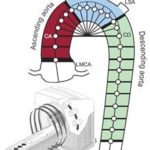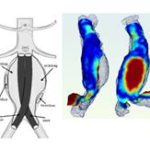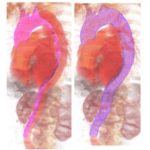Cardiovascular Engineering Lab specialized in digital imaging processing.
Director: Dr Damian Craiem,.
Keywords: Computed tomography, 4D-Flow MRI, Cardiovascular diseases, mathematical simulation, arterial biomechanics, in-vitro mechanical tests and in-vivo animal experimentation.
Researchgate link here.
Publications link here.
Members: Dr Sebastian Graf, Dr Franco Pessana, Dr Carlos Perazzo, Dr Mariano Casciaro, Dr. Ariel Pascaner, Ing. Federico Guilenea, Ing. Valentina Stipechi, Florencia Rocca, Caterina Galafassi, Sol Malacari, Manuela Veloso y Martina Zgaib.
 Our Group consists mainly of Biomedical Engineers who developed tools for the prevention, control and treatment of various cardiovascular diseases. These tools are aligned with the translational spirit of the Institute, starting from the conception of mathematical models and computational simulation, going through in vitro tests in tissues, in-vivo trials in animals and finally reaching specific applications for patients.
Our Group consists mainly of Biomedical Engineers who developed tools for the prevention, control and treatment of various cardiovascular diseases. These tools are aligned with the translational spirit of the Institute, starting from the conception of mathematical models and computational simulation, going through in vitro tests in tissues, in-vivo trials in animals and finally reaching specific applications for patients.
 One of the main topics of the Group is the prevention of cardiovascular diseases through non-invasive measurements performed in patients at risk. We have designed precise biomarkers for the early detection of diseases relying on models of arterial biomechanics, measurements of arterial stiffness, arterial wall thickness, analysis of endothelial function and quantification of atheroma plaques using ultrasound images, among others.
One of the main topics of the Group is the prevention of cardiovascular diseases through non-invasive measurements performed in patients at risk. We have designed precise biomarkers for the early detection of diseases relying on models of arterial biomechanics, measurements of arterial stiffness, arterial wall thickness, analysis of endothelial function and quantification of atheroma plaques using ultrasound images, among others.
Digital processing of three-dimensional images is another area of important development and innovation within the group. Work has been done with prediction of cardiovascular events conceiving medical image processing programs to quantify coronary and aortic calcifications. To address this problem, Artificial Intelligence techniques, especially Artificial Neural Networks, are being used for automatic calcification detection of the thoracic aorta.
In magnetic resonance imaging, applications are being developed to process images of innovative modalities such as the Flow4D sequence, which allows to visualize the anatomy and blood flow as a function of time in a complete volume.
 Regarding the treatment and monitoring of vascular diseases, modules have been programmed to quantify arterial geometry in the presence of aneurysms and dissections. To monitor patients treated with endovascular prostheses, special computer tools have been developed to evaluate the evolution of treatments. For further analysis, Computational Fluid Dynamics simulations have been incorporated in collaboration with National and International research groups.
Regarding the treatment and monitoring of vascular diseases, modules have been programmed to quantify arterial geometry in the presence of aneurysms and dissections. To monitor patients treated with endovascular prostheses, special computer tools have been developed to evaluate the evolution of treatments. For further analysis, Computational Fluid Dynamics simulations have been incorporated in collaboration with National and International research groups.
 The group has the ability to develop its own software and hardware modules and to integrate them for the needs of the Institute and the Favaloro University Hospital. The team members are trained researchers, fellows and advanced students of the Biomedical Engineering degree. Contact email: dcraiem@favaloro.edu.ar (damian-craiem.github.io)
The group has the ability to develop its own software and hardware modules and to integrate them for the needs of the Institute and the Favaloro University Hospital. The team members are trained researchers, fellows and advanced students of the Biomedical Engineering degree. Contact email: dcraiem@favaloro.edu.ar (damian-craiem.github.io)
The information in English, including the list of publications, can be found here
